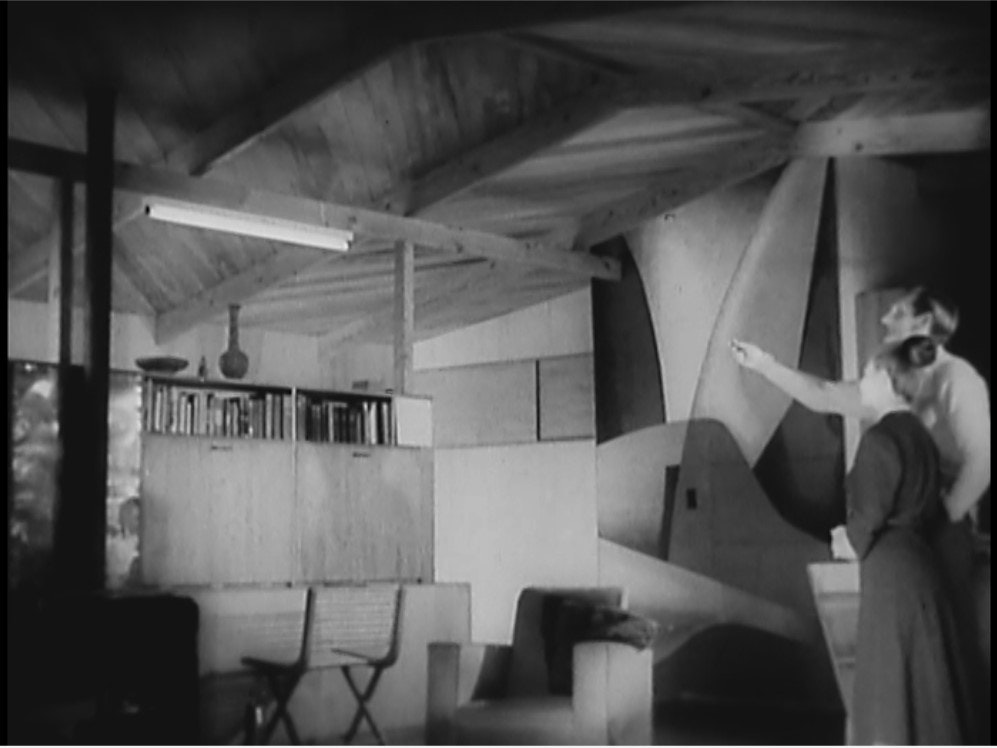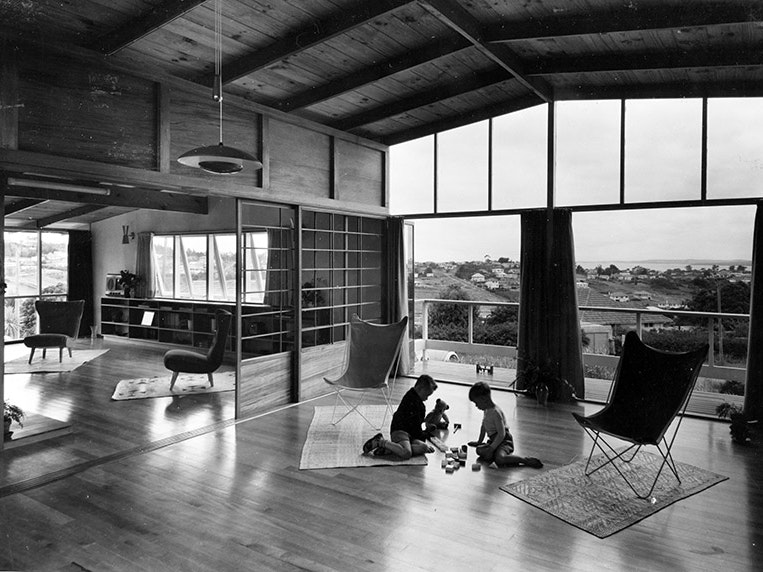
‘Experiment in Housing’ archive footage
Watch as Group Architects build their Second House at Takapuna, and visitors look at the completed First House.
Free museum entry for New Zealanders and people living in New Zealand
Open every day 10am-6pm
(except Christmas Day)
Free museum entry for New Zealanders and people living in New Zealand
‘We know there is another way of living in which a house is logically contrived for peace and comfort, where the sun brings life … and we mean to find it for ourselves and make it real.’
On the necessity for architecture, the manifesto of the Architectural Group, 1946
Group Architects manifesto: On the necessity for architecture (1.28 MB)
‘Architecture is the planning of our whole physical environment, and … only a vital and communal architecture can seize this chance … [to] build such a world as we know is possible.’
Group Architects saw architectural design as the key to developing a fairer, happier society. They promoted their ideas through their published manifesto reproduced here.
We New Zealanders live in a chaos of unplanned speculative building under an unthinking, self-seeking system of land sub-division. Our suburbias spread their tentacles along the city traffic routes; our children cross streets to get to school; our wives buy in inadequate and too-distant shops lining the main roadways; our hospitals are overcrowded; our transport system is overloaded; our homes are ill-planned, graceless and monotonous in their petty variety.
We know there is another way of living in which a house is logically contrived for peace and comfort, where the sun brings life without faded carpets, and in which leisure and beauty are not interred in respectable museums. And we mean to find it for ourselves and make it real to everyone who feels as we do. We shall not be satisfied until this outlook includes our whole environment–the places where we work or play, where our children spend their school days, our streets and parks, our cars and buses, the plates from which we eat, and the chairs in which we relax. Because we want this in New Zealand, overseas solutions will not do. New Zealand must have its own architecture, its own sense of what is beautiful and appropriate to our climate and conditions.
This concept of the whole environment as a planned and pleasant entity is architecture. Only architecture can successfully arrange this background to our daily lives.
. . . the individual
Planning is for the individual the only means by which he can achieve freedom from the petty time-consuming chores of every-day life and gain for himself the joys and satisfactions of a more leisured and cultured existence. If we plan the small things to function almost automatically, we can enjoy freer, fuller and more satisfying lives.
. . . techniques
You will ask how all this is to be done. Are we not aiming too high? We know that these things are physically possible. The means by which they are realisable are the gifts of science and industry.
Science has given us the machine. Industry has shown us mass-production. The machine is merely a better tool than the plane and hammer, as they were better than the flint axe and hone knife. Mass-production is the method by which we utilise the vast powers of this bigger tool. It is the only method by which we can do so to the full. Unless we decide what we want produced we shall not realise the potential of our industry through failing to use methods suitable to its capacities. The nature of the machine and the method of mass-production demand standardisation.
Wedded to these new powers, we have a fabulous and every-increasing wealth of new materials and methods of fabriaction. Research is continually presenting us with wider and larger powers. While we must always press on with our search for newer and better ways, we must remember that a denial of the nature of machine-production and its attendant standardisation can only mean a squandering of the possibilities before us.
. . . beauty
We must insist here that standardisation does not mean monotony. The brick is a standard which has been accepted for years. Timber sizes are standardised. Standardisation means merely an increase in the size of the units commensurate with the nature and capacity of this new and more efficient tool.
Standardisation of repitition was, in fact, the earliest principle of design on which all the great masterpieces of Classical and Renaissance times were based.
Choice, then, is necessary, not only for the full utilisation of our new powers, but to produce that sense of order and unity which is the basis of beauty. The disciplines according to which we make the necessary choice are (a) the nature of the machine, (b) the functions the building or object is designed to fulfil, and (c) the locak physical and social conditions. Physical limitations are not a discipline but a challenge to our ingenuity.
Other countries have to a certain extent solved these problems. Our problem is to develop an answer suitable to our own conditions.
. . . politics
The achievement of these things is a matter of practical politics, for the true concept of politics is “planning.” And we believe that “planning is politics.” Recent history’s drastic cycle of war and slump is a symbol of the failure of our present system. We believe that production must be for use and not for profit; that, therefore, architecture is not possible within a capitalist economy.
Fundamental to this point of view is the belief that architecture cannot be imposed on anybody. It can arise only out of the daily life of Everyman, and without Everyman there can be no architecture. Building nice houses for nice people is not architecture.
To design buildings, cups or motor-cars in the modernidiom while denying the validity of these concepts is surely to perpetuate eclecticism and hypocrisy. For if our logic ends with the “style” we use we are merely substituting the copy-book of steel and glass for that of column and cornice. The spirit of modern architecture must permeate the whole life of him who practises its skills. He cannot leave it on his drawing board.
We are not forgetful of the dangers inherent in an economy of use or of its concomitant political dangers of bureaucracy and dictatorship. These we regard only as difficulties to be overcome and which we may solve by getting together to work out satisfactory methods of planning and government.
. . . economics
Since the aim of architecture is the satisfaction of human needs and aspirations, and since this planning is now for the first time physically possible, it follows that it must be financially possible. To deny ourselves fulfilment when we have the capacity would be foolish indeed.
Furthermore, efficient planning can effect for us great economies, not only of money, but of our natural resources and of our own time and energies. Only planning can check the widespread squandering of the wealth of our land that is so common a feature to-day.
. . . philosophy
Architecture, then, is neither a livelihood nor a profession, nor even “beautiful building.” It is not only an art and a science; it is basically the means to achieve a civilised and cultured society. Only noble human ends produce good architecture. Architecture is the planning of our whole physical environment, and science having given us the chance of fashioning it to our heart’s desire, only a vital and communal architecture can seize this chance and by ordering its components build such a world as we know is possible.
Therefore we must, each one of us, forgetting petty gains or differences, sink our skills and energies in the common task.
It is part of this resolution that architecture is possible only where production is for use, and that it can arise only from the main stream of society. A vital architecture springing from the lives of the people represents the integration of all social and political effort, the expression of the culture of our society.
. . . the magazine
In doing our part to further the ideals we have set out in this manifesto, we intend to publish a magazine of social planning. Its aims will be to engender a popular determination to achieve these things and to assist in the development of a sturdy vernacular architecture as the means by which we shall make them possible.
correspondence:
24 brentwood ave,
mt eden, auckland

Watch as Group Architects build their Second House at Takapuna, and visitors look at the completed First House.

The 1952 Auckland exhibition Art and Design introduced New Zealanders to a vision for a more equal, happier way of life that grew from the devastation of World War II. Modern Living offers a lens into this ground-breaking exhibition, and an exciting era of new design in Aotearoa.
Closed
22 Aug 2020 – 26 Apr 2021
Exhibition Ngā whakaaturanga